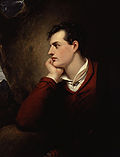
She walks in beauty, like the night
Of cloudless climes and starry skies;
And all that's best of dark and bright
Meet in her aspect and her eyes
Thus mellow'd to that tender light
Which heaven to gaudy day denies.
One shade the more, one ray the less,
Had half impair'd the nameless grace
Which waves in every raven tress,
Or softly lightens o'er her face;
Where thoughts serenely sweet express
How pure, how dear their dwelling-place.
And on that cheek, and o'er that brow,
So soft, so calm, yet eloquent,
The smiles that win, the tints that glow,
But tell of days in goodness spent,
A mind at peace with all below,
A heart whose love is innocent! [1]Contents
"She Walks in Beauty" is a short lyrical poem in iambic tetrameter written in 1814 by Lord Byron, and is one of his most famous works. [2]
It is said to have been inspired by an event in Byron's life. On 11 June 1814, Byron attended a party in London. Among the guests was Mrs. Anne Beatrix Wilmot, wife of Byron's first cousin, Sir Robert Wilmot. He was struck by her unusual beauty, and the next morning the poem was written. [3]
It is thought that she was the first inspiration for his unfinished epic poem about Goethe [ which? ], a personal hero of his. In this unpublished work, which Byron referred to in his letters as his magnum opus, he switches the gender of Goethe and gives him the same description of his cousin.[ citation needed ]
